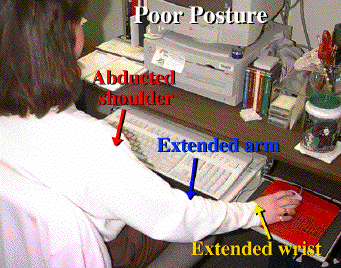
Cornell University Ergonomics Web

The Problem
JS is right handed and works most of the time on a computer. She was experiencing increasing amounts of pain in her right shoulder and wrist and discomfort in her right upper and lower arm. She had received physical therapy treatment and intermittently wore a wrist brace. However, symptoms were continuing to worsen when she contacted the Cornell Ergonomics group for advice.
Pre-intervention Workstation Arrangement
JS worked at a 27" computer desk. Her keyboard and mouse were placed on a retractable, flat keyboard tray with an attached mouse platform at the same height and to the right of the tray (see Figures 1 and 2).
Figures 1 and 2 clearly show that this keyboard and mouse arrangement forced her to work with her right arm extended, abducted away from the body, and with her right wrist in sustained extension. Her keyboard tray also forced her to work with her arms upwardly inclined and with her hands in extension. Although advertised as an "ergonomically designed" computer workstation, analysis showed this arrangement to be the source of her musculoskeletal problems.
Figure 1 Pre-intervention keyboard arrangement. 
 Figure 2 Pre-intervention mouse arrangement.
Figure 2 Pre-intervention mouse arrangement.
Ergonomic Intervention
From analysis of JS's working posture, we concluded that she needed a keyboard and mouse arrangement that would fit a 27" desk, and yet still allow her to work with her arms relaxed and within the immediate work zone, from elbow to elbow, and with her wrists sustained in a neutral posture. Office desks are normally set at 29"-30", so refitting the 27" desk, which was not height adjustable, with an ergonomic keyboard system, proved to be quite a challenge. From the options examined, we selected a Preset tilt-down keyboard system, and after installation we evaluated the effects of this system.
The position adjustable mouse platform (see Figure 4) allows her to work
with her right arm relaxed, and close to the body. In this posture her right
shoulder is relaxed and her right wrist is in neutral posture. The slide
in-plane document holder allows her to work without either a twisted or
awkward neck posture, which also allows her shoulders to relax.
Post-intervention Workstation Arrangement
A Preset tilt-down keyboard system was fitted to the 27" pedestal desk
(see Figure 3). This system allows JS to work at her keyboard while sitting
in her chair, with her arms relaxed and her wrists in a neutral posture.
 Figure 3 Post-intervention keyboard arrangement.
Figure 3 Post-intervention keyboard arrangement.
The position adjustable mouse platform (see Figure 4) allows her to work
with her right arm relaxed, and close to the body. In this posture her right
shoulder is relaxed and her right wrist is in neutral posture. The slide
in-plane document holder allows her to work without either a twisted or
awkward neck posture, which also allows her shoulders to relax.
 Figure 4 Post-intervention mouse arrangement.
Figure 4 Post-intervention mouse arrangement.
Analysis of JS's new working posture with the Preset tilt-down keyboard system shows that she can now perform all of her computer work with her arms relaxed and within the immediate work zone, from elbow to elbow, and with her wrists in a neutral posture (see Figure 5).
Figure 5 Post-intervention keyboard and mouse arrangement. 
JS is now free from musculoskeletal symptoms and discomfort.
For further information on this case study contact Alan Hedge by email at ah29@cornell.edu